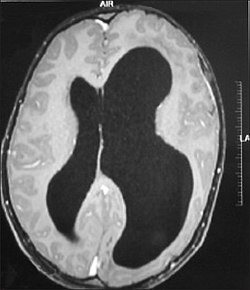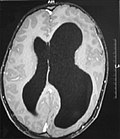Megalencephaly
Megalencephaly, often referred to as macrencephaly and abbreviated as MEG, refers to a neurodevelopmental disorder where there's an abnormal enlargement of the brain. Specifically, the brain's weight is found to be 2.5 standard deviations above the mean for the general population, making it a distinguishing and significant feature of the condition.
Diagnosis[edit]
The presence of megalencephaly is typically identified at birth or during infancy. The primary diagnostic tool for confirming this condition is Magnetic Resonance Imaging (MRI). The imaging provides clear insights into the size and structure of the brain, confirming the suspicion of megalencephaly.
Causes[edit]
Current research posits that a mutation in the PI3K-AKT pathway serves as the central etiological factor. This mutation is associated with unchecked proliferation of brain tissues, culminating in the enlargement characteristic of megalencephaly. As science delves deeper into understanding the genetic roots of this condition, two distinct syndromes associated with brain overdevelopment have been identified:
- Megalencephaly-capillary malformation (MCAP): This syndrome combines the features of megalencephaly with vascular abnormalities.
- Megalencephaly-polydactyly-polymicrogyria-hydrocephalus (MPPH): This is a more complex manifestation, involving not only brain enlargement but also the presence of additional fingers or toes, abnormal cortical development, and accumulation of cerebrospinal fluid in the brain.
Prevalence[edit]
The prevalence of megalencephaly in the general population is approximately 2%, meaning 1 out of 50 children might exhibit characteristics consistent with this condition.
Associated Conditions[edit]
While several neuropsychiatric disorders can emerge in the context of megalencephaly, the most common association appears to be with autism. Autism, a developmental disorder affecting communication and behavior, seems to have a higher likelihood of occurrence in individuals with megalencephaly.
Treatment and Management[edit]
As of now, there's no definitive cure for megalencephaly. Interventions primarily focus on addressing and reducing the deficits and challenges associated with comorbid conditions like autism. Therapeutic approaches might involve physical therapy, behavioral therapy, and sometimes medication to manage specific symptoms.
Research in the field is ongoing and is mainly pivoted toward the development of inhibitors that can target and modulate the mutated pathway responsible for the condition.
See Also[edit]
References[edit]
<references />
|
|
|
| Congenital malformations and deformations of nervous system | ||||||||||
|---|---|---|---|---|---|---|---|---|---|---|
|
| Congenital malformations and deformations of nervous system | ||||||||||
|---|---|---|---|---|---|---|---|---|---|---|
|
Megalencephaly[edit]
-
Megalencephaly
-
Megalencephaly
-
Megalencephaly
Ad. Transform your life with W8MD's Budget GLP-1 injections from $75


W8MD offers a medical weight loss program to lose weight in Philadelphia. Our physician-supervised medical weight loss provides:
- Weight loss injections in NYC (generic and brand names):
- Zepbound / Mounjaro, Wegovy / Ozempic, Saxenda
- Most insurances accepted or discounted self-pay rates. We will obtain insurance prior authorizations if needed.
- Generic GLP1 weight loss injections from $75 for the starting dose.
- Also offer prescription weight loss medications including Phentermine, Qsymia, Diethylpropion, Contrave etc.
NYC weight loss doctor appointmentsNYC weight loss doctor appointments
Start your NYC weight loss journey today at our NYC medical weight loss and Philadelphia medical weight loss clinics.
- Call 718-946-5500 to lose weight in NYC or for medical weight loss in Philadelphia 215-676-2334.
- Tags:NYC medical weight loss, Philadelphia lose weight Zepbound NYC, Budget GLP1 weight loss injections, Wegovy Philadelphia, Wegovy NYC, Philadelphia medical weight loss, Brookly weight loss and Wegovy NYC
|
WikiMD's Wellness Encyclopedia |
| Let Food Be Thy Medicine Medicine Thy Food - Hippocrates |
Medical Disclaimer: WikiMD is not a substitute for professional medical advice. The information on WikiMD is provided as an information resource only, may be incorrect, outdated or misleading, and is not to be used or relied on for any diagnostic or treatment purposes. Please consult your health care provider before making any healthcare decisions or for guidance about a specific medical condition. WikiMD expressly disclaims responsibility, and shall have no liability, for any damages, loss, injury, or liability whatsoever suffered as a result of your reliance on the information contained in this site. By visiting this site you agree to the foregoing terms and conditions, which may from time to time be changed or supplemented by WikiMD. If you do not agree to the foregoing terms and conditions, you should not enter or use this site. See full disclaimer.
Credits:Most images are courtesy of Wikimedia commons, and templates, categories Wikipedia, licensed under CC BY SA or similar.
Translate this page: - East Asian
中文,
日本,
한국어,
South Asian
हिन्दी,
தமிழ்,
తెలుగు,
Urdu,
ಕನ್ನಡ,
Southeast Asian
Indonesian,
Vietnamese,
Thai,
မြန်မာဘာသာ,
বাংলা
European
español,
Deutsch,
français,
Greek,
português do Brasil,
polski,
română,
русский,
Nederlands,
norsk,
svenska,
suomi,
Italian
Middle Eastern & African
عربى,
Turkish,
Persian,
Hebrew,
Afrikaans,
isiZulu,
Kiswahili,
Other
Bulgarian,
Hungarian,
Czech,
Swedish,
മലയാളം,
मराठी,
ਪੰਜਾਬੀ,
ગુજરાતી,
Portuguese,
Ukrainian






